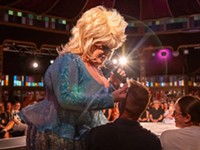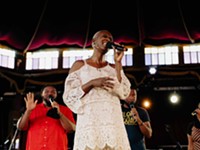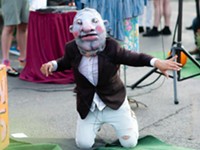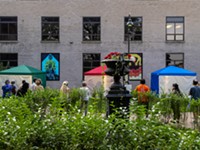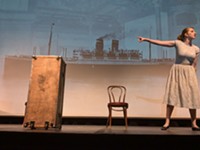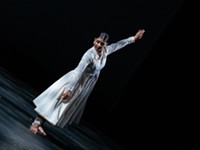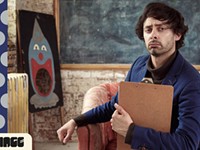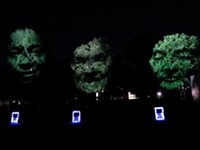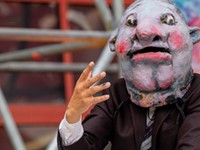Hoodoo history
“The Unluckiest Corner” | Parcel 5 | Sept. 20, 21 | $18 | Ages 13+
Pull up a patch of grass, throw on a pair of headphones and follow Matt Rogers of The Lost Borough on an audio journey through Rochesterville. This year’s only Fringe x Parcel 5 show, “The Unluckiest Corner,” recounts the history of “Hoodoo Corner,” the spot’s original name.
From the history of the Liberty Pole(s) and the first murder victim in Rochester, William Lyman, to the 100-acre track and the first urban shopping area in the United States, there’s myriad discoveries to be made about “The Unluckiest Corner.” Rogers began his tumble down the rabbit hole of local lore with his apparel company, The Lost Borough, which specializes in historical hat-tip merch. He has a great voice for the facts he recounts, fit for an Audible narrator or auditory museum tour guide. He’s woven thematic music under the storytelling, creating an emotional tone for each tale (and some of them are dark).
With a 5:30 p.m. start time and running just 30 minutes (though Rogers remarked it started at a 90-minute run time), “The Unluckiest Corner” is a perfect pregame for one of the weekend’s later shows. Tip for those who didn’t read the description thoroughly enough (that’s me): bring a blanket or chair if you don’t want to sit on the grass and bug spray for the Parcel’s only current inhabitants. —LEAH STACY
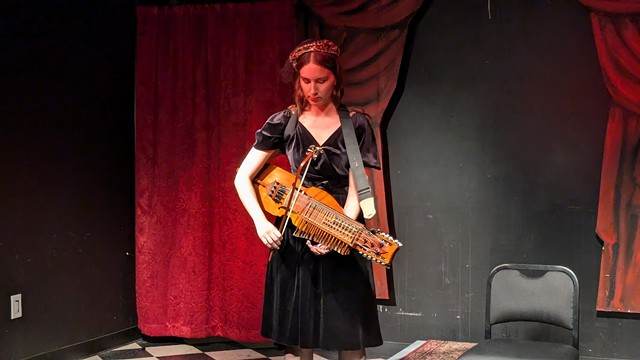
Fantastic fiddle
"The Fiddle Witch" | The Spirit Room | Sept. 18 | SOLD OUT | Ages 5+
Alyssa Rodriguez, an occasional host for WXXI Classical, is also an ambassador of Nordic folk music. On Tuesday night, she provided the audience with the uncommon opportunity to hear the Swedish folk instrument called the nyckelharpa, or keyed fiddle. The nyckelharpa, is bowed, but individual notes are played by pressing keys rather than by pressing strings down on the fingerboard of the instrument as you would with a fiddle
In many of the tunes, a low drone was constant. Early on, Rodriguez played the original work “Uncertain Times,” inspired by the Minimalist works of classical composer Philip Glass. The music was both straightforward and enigmatic.
Rhythmically, the songs generally had a waltz feel, but with a rustic vibe. With the nyckelharpa, there seemed to be more friction between the bow and strings than in the case of the violin, and the instrument had a metallic timbre.
All the compositions had a dance-like quality, even the more mournful pieces. In fact, the nyckelharpa seemed to resonate more and take on a more mellifluous tone when played in a minor key. Even a song called “The Death Waltz” sounded joyful.
Rodriguez rarely accessed the instrument’s higher register, but when she did it provided the audience with the concert's most beautiful moments. The nyckelharpa struck me as an instrument of solitude — an impression made even stronger by the fact that it is so seldom heard in America. —DANIEL J. KUSHNER
Open-hearted opera
“Songs to Drink Wine 2” | The Spirit Room | Sept. 18 | $14 | Ages 13+
The Rochester Fringe Festival features no shortage of eccentric performances, often combining multiple artistic mediums. But it was refreshing to hear a straightforward voice recital titled “Songs to Drink Wine 2” featuring popular opera arias and lesser-known art songs from soprano Sophia Mostafa.
From the first few notes of George Gershwin’s famous aria “Summertime” from the opera “Porgy and Bess,” Mostafa sang with a light, buoyant tone that was exceedingly listenable.
At times, her vibrato was a bit heavy-handed in spots, and her voice sounded less free. But overall, she sang with vibrancy and a sense of fun. Her love of singing came through loud and clear.
Although her performance of more obscure songs by the likes of Erik Satie and William Bolcom was enjoyable, her high notes were so radiant that I was left wanting to hear more coloratura arias, like “Quando m’en vo” from Giacomo Puccini’s beloved opera “La bohème” and “O mio babbino caro” from his one-act work “Gianni Schicchi.”
The relevance of the theme, “Songs to Drink Wine 2,” was never made clear in the performance of the songs. But whether you were partaking in the fruit of the vine as you listened or not, Mostafa provided an excellent escape. —DANIEL J. KUSHNER
“The Unluckiest Corner” | Parcel 5 | Sept. 20, 21 | $18 | Ages 13+
Pull up a patch of grass, throw on a pair of headphones and follow Matt Rogers of The Lost Borough on an audio journey through Rochesterville. This year’s only Fringe x Parcel 5 show, “The Unluckiest Corner,” recounts the history of “Hoodoo Corner,” the spot’s original name.
From the history of the Liberty Pole(s) and the first murder victim in Rochester, William Lyman, to the 100-acre track and the first urban shopping area in the United States, there’s myriad discoveries to be made about “The Unluckiest Corner.” Rogers began his tumble down the rabbit hole of local lore with his apparel company, The Lost Borough, which specializes in historical hat-tip merch. He has a great voice for the facts he recounts, fit for an Audible narrator or auditory museum tour guide. He’s woven thematic music under the storytelling, creating an emotional tone for each tale (and some of them are dark).
With a 5:30 p.m. start time and running just 30 minutes (though Rogers remarked it started at a 90-minute run time), “The Unluckiest Corner” is a perfect pregame for one of the weekend’s later shows. Tip for those who didn’t read the description thoroughly enough (that’s me): bring a blanket or chair if you don’t want to sit on the grass and bug spray for the Parcel’s only current inhabitants. —LEAH STACY

- DANIEL J. KUSHNER.
Fantastic fiddle
"The Fiddle Witch" | The Spirit Room | Sept. 18 | SOLD OUT | Ages 5+
Alyssa Rodriguez, an occasional host for WXXI Classical, is also an ambassador of Nordic folk music. On Tuesday night, she provided the audience with the uncommon opportunity to hear the Swedish folk instrument called the nyckelharpa, or keyed fiddle. The nyckelharpa, is bowed, but individual notes are played by pressing keys rather than by pressing strings down on the fingerboard of the instrument as you would with a fiddle
In many of the tunes, a low drone was constant. Early on, Rodriguez played the original work “Uncertain Times,” inspired by the Minimalist works of classical composer Philip Glass. The music was both straightforward and enigmatic.
Rhythmically, the songs generally had a waltz feel, but with a rustic vibe. With the nyckelharpa, there seemed to be more friction between the bow and strings than in the case of the violin, and the instrument had a metallic timbre.
All the compositions had a dance-like quality, even the more mournful pieces. In fact, the nyckelharpa seemed to resonate more and take on a more mellifluous tone when played in a minor key. Even a song called “The Death Waltz” sounded joyful.
Rodriguez rarely accessed the instrument’s higher register, but when she did it provided the audience with the concert's most beautiful moments. The nyckelharpa struck me as an instrument of solitude — an impression made even stronger by the fact that it is so seldom heard in America. —DANIEL J. KUSHNER
Open-hearted opera
“Songs to Drink Wine 2” | The Spirit Room | Sept. 18 | $14 | Ages 13+
The Rochester Fringe Festival features no shortage of eccentric performances, often combining multiple artistic mediums. But it was refreshing to hear a straightforward voice recital titled “Songs to Drink Wine 2” featuring popular opera arias and lesser-known art songs from soprano Sophia Mostafa.
From the first few notes of George Gershwin’s famous aria “Summertime” from the opera “Porgy and Bess,” Mostafa sang with a light, buoyant tone that was exceedingly listenable.
At times, her vibrato was a bit heavy-handed in spots, and her voice sounded less free. But overall, she sang with vibrancy and a sense of fun. Her love of singing came through loud and clear.
Although her performance of more obscure songs by the likes of Erik Satie and William Bolcom was enjoyable, her high notes were so radiant that I was left wanting to hear more coloratura arias, like “Quando m’en vo” from Giacomo Puccini’s beloved opera “La bohème” and “O mio babbino caro” from his one-act work “Gianni Schicchi.”
The relevance of the theme, “Songs to Drink Wine 2,” was never made clear in the performance of the songs. But whether you were partaking in the fruit of the vine as you listened or not, Mostafa provided an excellent escape. —DANIEL J. KUSHNER


